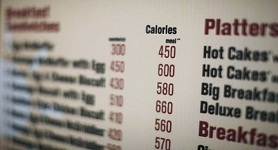By: Bethany Richardson
Personally, I am not always the biggest fan of calorie counts when I’m out to eat. I generally cook most of my own meals at home, being careful to choose healthy recipes with wholesome ingredients, and make exercise a priority. However, about once a week or so, I like to forsake my kale-and-turbokick routine to go out for an indulgent meal without the guilt, which can be hard to do with those pesky numbers staring at you from the menu. I realize that for the good of the population as a whole, displaying calorie counts is beneficial and necessary; this is particularly true for frequent travelers, like my dad, who inevitably end up eating many meals on the road or at the airport, which don’t always boast the most nutritionally superior choices.
I recently came upon an op-ed video from the New York Times by Casey Neistat that explores the discrepancy between calorie counts displayed by restaurants and the number of calories measured instrumentally. He states, that according to the health department, stores must post calorie counts, but the accuracy is not verified. The video is only about six minutes long, but reveals a pretty astounding difference between projected and actual calories in the foods researched. With the help of two food scientists from the Obesity Research Center at St. Luke’s Roosevelt, Neistat analyzed a variety of foods they he might actually pick up during a normal day, such as a muffin, Starbucks beverage, and Chipotle burrito. Although some of the products were within a reasonable range of the estimated value (which could easily vary depending on which employee is making the item), some of the actual foods were much higher- including a pre-packaged supposedly “healthy” sandwich that measured as twice the listed calorie count! I can also very much appreciate his analysis of how his research could be improved upon, such as increasing sample size, which is something we as scientists do with each experiment.
In the end, Neistat would have unknowingly consumed approximately an extra 550 calories per day if this was his actual meal plan. Over time, this could easily lead to a great deal of weight gain and subsequent health problems. Hopefully, this video will help to prompt change among the restaurant community to improve accuracy of their displayed calorie counts. While preparing your meals at home is generally the best idea, sometimes we have no choice, and it would be good to have reliable data to base nutritional choices on.
What is your opinion on restaurant calorie counts? Are they necessary and in what ways would you improve the availability of information?
Photo credit: http://www.nj.com/news/index.ssf/2010/01/nj_chain_restaurants_are_requi.html






I totally agree with you. I think the people who actually need to take into account the calorie counts, won’t give them a second look and people who are health-conscious only go out to eat as a treat, unless they are traveling a lot or something. I have mixed feelings about it. It doesn’t surprise me that they aren’t the most accurate, especially in a food service setting.
It makes me wonder if all packaged foods have accurate nutritional information- I would expect them to be better since they are under more scrutiny, but it would be interesting to do a similar investigation.
I still think the calorie count still makes a significant regardless if it is accurate or not. The calorie count would still deliver and alert the consumer about what they are taking to an extend. I have friends that doubt both calorie counts and nutritional facts table. I agree that sometimes, a random check would reveal the truth and acts as a way to remind food businesses to be truthful to their consumer.